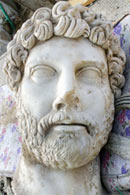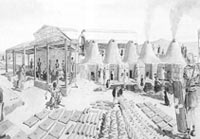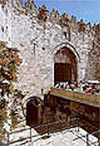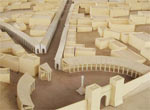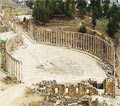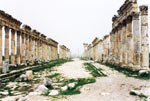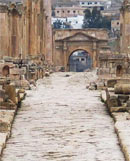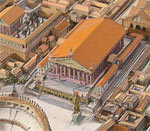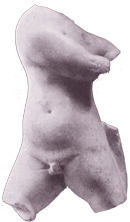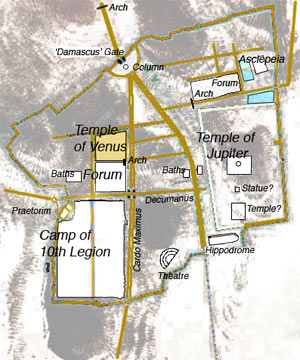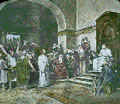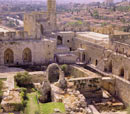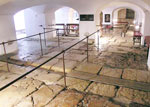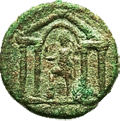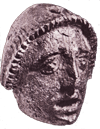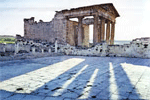A Second War with Rome
"At this time, the Jews started a war because they were forbidden to mutilate their genitals."
– Historia Augusta, Hadrian 14.2.
The Emperor Hadrian (117-138) – Publius Aelius Traianus Hadrianus.
This massive head is from a superb 16' marble statue of the emperor found in a bathhouse at Sagalassos, Turkey, in July 2007.
Imbued with the philosophic spirit of Hellas, Hadrian was equally contemptuous of Jews and – as far he was aware of them – the fractious sects of Christians.
Forced into a 3-year war he did not want, Hadrian imposed a mid-east peace settlement by taking Judaea captive. He expelled the Jews from Jerusalem, renamed the province Palestine after the ancient Philistines, and built Aelia Capitolina.
"The Romans shall come and take away both our place and nation." – John 11.48.
The Jewish "nation" was abolished after the second, not the first, Jewish war with Rome.
Was Jesus, the hero of the gospels, divinely prescient – or was the author of John's gospel merely describing this 2nd century reality?
Mark of the Legion

A tile from a legionary kiln, stamped with LXFRE – Legio X Fretensis.
With the Romans no longer facing a military threat from the Jews, the X Legion went into business making bricks, pipes, tiles, etc., each stamped with the legionary insignia or distinctive symbol, a boar.
Mass production, Roman-style
The Roman brick factory occupied the site of today's Jerusalem Convention Centre – two miles west of the Old City.
Porta Neapolitana
Remains of the Roman north gate are still visible below today's Damascus Gate.
Aelia had four major gates, one of each side of town (today's Damascus, Jaffa, Zion and Lions' Gates).
The main entrance was the northern gate, the Porta Neapolitana, through which passed a new road to the provincial capital, Caesarea.
The Arab name for the portal today is "Bab el-Amud" ("Gate of the Column"), preserving a memory of the monument which stood either in the semi-circular plaza within the gate, similar to the oval forum at nearby Gerash, or possibly outside the gate.
The monument almost certainly featured a statue of Hadrian himself, or possibly his guardian and father-by-adoption, Trajan.
A semi-circular plaza
A model of Aelia's distinctive plaza and the two cardines – colonnaded streets which crossed the city.
The Cardo Minimus followed the line of the Tyropoeon Valley, the Cardo Maximus dissected the city on a north-south route. Each of the two thoroughfares had a covered walkway on either side lined with shops.
The oval forum at Gerash.
Cardo Maximus
Now a feature of an upscale shopping mall, the western cardo is about 4 metres below the present ground level.
Shops lined the cardo – just like any modern high street.
Excavations in the Jewish Quarter indicate that the cardo here was the work of Justinian in the 6th century – an embellishment to match his new church ("Nea") just north of the theatre.
Cardo Maximus at Apamea, Syria
The axial roads of Aelia had central colonades of two rows of columns. The total width of the road equalled a modern 6-lane highway (22.5 metres).
In the degenerate age that followed the Romano-Hellenistic period, hovels were constructed along the centre of each carriageway, creating narrow lanes where once had run broad avenues.
The Decumanus Maximus at Aelia would have looked much like this example from Gerash.
Hadrian's other temple to Venus.
How the Temple of Venus and Rome may have looked in its heyday.
Ruination really took hold in 625 when the gold-plated bronze tiles which covered the roof were stripped off by Pope Honorius for reuse on the church of Peter.
The torso of a statue from the Temple of Jupiter which stood on Temple Mount.
|
For two hundred years, the municipality of Aelia – the erstwhile city of Jerusalem – was demonstrably and triumphantly pagan, enjoying all the refinements of a Roman colonia. It was also a garrison city for legio X Fretensis – the Roman legion which had destroyed Gamala, Qumran and Masada. In the siege of Jerusalem in 70 AD the Tenth had camped on the Mount of Olives, and rained ballisticae onto the city. In the war of 135 it had reduced the fortress of Betar, killing the messianic claimant and the last of his supporters. Post-war, legio decima was heavily involved in reconstruction, its expertise deployed in a vast number of public works. This pagan past is dimly perceived today, even though the Roman imprint determined the size and layout of the city for more than a thousand years. "Pagan Jerusalem" is regarded by all and sundry as an alien interlude in an essentially Judeo-Christian story. Yet Aelia Capitolina is crucial in the history of Christianity. It was while Jupiter was venerated on "Temple Mount" and Venus honoured in the heart of the city that the fable of Jesus was given form and substance. It was upon, not the city of Herod, but the 2nd century city of Hadrian that the gospellers imposed their fable.
A Roman Colonia
If 4th century Christian historian Eusebius is to be believed, the new city that Emperor Hadrian built upon the ruins of Jerusalem was colonized by a "new race of Gentiles". When the gospels took the shape familiar to us today Jerusalem was a memory. In its stead stood the Romano-Hellenic city of Aelia Capitolina, a minor town of the province of Syria Palestina.
Coins issued by Hadrian confirm that Colonia Aelia Capitolina was founded about the year 132 AD, before, not after, the second war of the Jews. It was originally intended to be the emperor's gift to the Jewish people, drawing them into the world empire of Rome. A Roman colony entitled the residents to many tax benefits not awarded to citizens of a regular polis. But soon after Hadrian returned to the west resentful religious reactionaries placed themselves at the head of impoverished peasants and urban malcontents and began a well-planned second war against Rome. Evidently, in munitions workshops Jewish craftsmen had deliberately spoiled weapons intended for the Roman army and stored the rejects for future use. Three years of vicious warfare against rebels led by Simon ben Kosiba left the emperor furious with the Jews. When the revolt was eventually crushed, Hadrian wiped off Judaea from the map. Privileges which the Jews had enjoyed from the time of Julius Caesar were revoked. Except for the ninth of Av, the day of mourning, the Jews faced penalties for even laying eyes on the city. Under the edicts of Hadrian the Roman administration made no distinction between Judeo-Christians and orthodox Jews – all were expelled. Not to be thwarted, the emperor pressed ahead with his plans for the new city. His architects marked out a colony extending further north than the earlier Herodian city – its full extent is yet to be established. But Aelia would no longer be a city for the Jews. Under new Roman laws they were forbidden to live in the city or anywhere between Jerusalem and Hebron. Capital punishment faced any Jew who so much as stepped foot in the city. The Aelia which arose would make no concessions to the Jews. The city itself, no longer the hub of a theocracy, took on the status of a minor provincial town. No major trade route passed its way and rabbinic Judaism established itself elsewhere. Caesarea, the provincial capital, became the city of choice for both the Jewish elite and ambitious artisans, attracted by the thriving port and Hellenistic lifestyle. Aelia, lost in the high country, was on the road to nowhere. But Aelia was a city with a dimly perceived "past" that would colour a wondrous tale of a saviour god. Who would have anticipated that within a few centuries this minor provincial town would flourish as the "centre of the earth" and enjoy the dubious honour of being the maelstrom of conflict and war for the next two millennia?
Jesus in the city of Hadrian?
The whole world knows that the gospel pageant is set in the first half of the first century. Rather more pertinent is determining precisely when and by whom the fabulous tale was concocted. The inspired religious writers of the second century – who quite possibly had no familiarity with real Jerusalem at all – would have been very aware that the city had changed drastically in a century of turmoil and war. But, in fact, that hiatus helped to establish their salvation drama as a cosmic event. The gospellers' Jerusalem was no mere geography but was the Holy City, a sacred mountain where God had communed with his chosen people. Aelia's existence on the ruins of Jerusalem – erasing all that had gone before – underscored the transcendent and timeless nature of the gospel message. Divinity had intruded briefly into human affairs and, for the Christian story writers, the comings and goings of Jesus had been a sacred drama, occurring not in simple past and common place but in "sacred time" and "sacred space". Sacred space is replete with a Holy of Holies, hallowed ground, Paradise, and – inevitably – an Abode of the Damned. Sacred space has place for a "centre", "four corners" and the "ends" of the earth and for a firmament that "divides the waters from the waters" (Genesis 1.6). In sacred space zodiacal coordinates and the position of the stars have meaning ("And there shall be signs in the sun, and in the moon, and in the stars" – Luke 21.25.) Sacred time is no less a departure from rationality – and is certainly not linear, chronological and unidirectional. What importance has normal time to eternal truths or eternal beings? – a day is as a year or a millennium. Sacred time has an "In the Beginning", an "End Time", a "time before time", "first and last days" and, by inference, an indeterminate "meantime". The once and future king is always with us, his pithy "wisdom" statements are true now, have always been true, and will remain true for all time. The superhero who utters them does so in times past, present and future. In this quirky universe Joshua can make the sun stand still and a sacrificial redeemer can still live two thousand years after his death, forever dying and resurrecting. Allegorical or supposed "higher truths" exist in a dimension all their own and a fake historicism confuses the unwary. The problem arises when the theological dreamscape is misinterpreted as literal truth and lesser minds impose the cosmic event onto a real geography and intrude a holy pageant into real history. The "fit" is gross, the anachronisms rife. Here and there, a particular town or place may be favoured as a candidate for the miraculous but "mysteries", enigmas and anomalies abound. By its very nature the supernatural cannot be compelled to fit the merely natural. Only within the imprecision of the human mind can the circle be squared, water run up hill, and cool and measured rationality coexist with the passion, emotionalism and irrationality of faith. The discordance is celebrated as "spirituality". Thus it is not surprising that the gospels can mention Jerusalem more than a hundred times yet make fewer than half a dozen references to any named or identifiable topography. The "pre-war" sacred Jerusalem of their tale is glimpsed only in the most general terms and the story, for the most part, avoids all specifics as it moves Jesus about his "theatrical" setting. Thus, for example, for that climatic "last supper" JC's instructions for finding a suitable venue for the passover meal are decidedly "unworldly":
The Praetorium According to the gospel fable, it was the praetorium where JC was tried and condemned. But what praetorium was that? After Herod Archelaus was deposed in 6 AD his palace on the western side of the city of Jerusalem was sequestered as the seat of the Roman Prefect, complete with "judgement hall". This was the praetorium. It was NOT, as Christians long-supposed, located in the Antonia tower, a fortress built by Herod and named for his Roman patron.
So Who DID sit on a judgement seat? Our old friend Josephus reports the tribunal of a much later procurator than Pilate – Gessius Florus, whose provocations forced the Jews into war:
Not only do we have a Roman Procurator flogging and crucifying his critics but victims include the "quiet people" ("Jesus gave no answer") and "Jews of Roman dignity". So much for St Paul's wondrous get-out-of-jail card "I am a Roman"! With more than 3,000 victims, including infants, it is hard to give credence to the notion – dreamed up by the 2nd century Christian 'historian' Hegesippus – that it was the "martyrdom of James the Less" and not the barbarity of Florus that was the catalyst of war.
Jesus was here? No chance.
"Fortress Antonia" The recogntion of Hadrian's forum and monumental arch has serious implications for the identification of that other confectionery in models of ancient Jerusalem – the "Antonia Fortress". It was the "lithostrotos" more than anything else, which convinced the first archaeologists that they had located the Antonia. In fact, the fortress has never been found, despite pious enthusiasms:
If Josephus can be relied upon, this vast "multi-city palace", accommodating camps and an entire legion, cannot be the same "tower Antonia" thrown down by Titus in a matter of days during the siege of 70 AD. In reality, a part of what is now the esplanade of Temple Mount itself must have been the site of the Fortress Antonia. If this is the case, then Herod's Temple actually must have occupied a site further south, somewhere in the vicinity of the Al Aksa mosque. This would place it much closer to the sacred spring of Gihon – and Tacitus reports that the spring was indeed within the temple:
In any event, the Roman garrison, several thousand strong, provided rich opportunities for the enterprising. It is not unreasonable to suppose that, in the middle decades of the 2nd century, some Jews professed Christian beliefs in order to reoccupy businesses and premises left derelict for more than half a century.
A new god in residence – and the "wall of Jesus" At the main intersection of Aelia, just north of where the Cardo Maximus crossed the Decumanus Maximus, Hadrian's architects laid out a vast forum. A sacred precinct was built adjacent to this forum (in the area now occupied by the Church of the Holy Sepulchre, the purported tomb of Jesus and Calvary itself). The sources give conflicting reports but it seems the honoured god of the pagan sanctuary was Hadrian's own family deity Venus (Aphrodite to the Greeks), a goddess also sacred to the occupying 10th legion: the emblem on its Vexillum standard was Taurus the bull, the zodiacal sign for April-May, the time of year when the legend was founded and auspicious to Venus. Although destroyed completely by the triumphant Christians 180 years later, the temple doubtless had much in common with the dual temple to Venus and Rome built by the emperor at the same time in the imperial capital. The Hadrianic temple was surrounded by a temenos (a sanctified area, marked by a protective wall) with a main entrance on the Cardo Maximus. The church built centuries later by Constantine retained this feature. Excavation work has revealed the remains of the boundary wall, which, among other things, proves that the Christian holy sites were NOT buried by a vast infill. Stonework of Hadrian's temple exists on the same level as the later Constantinian basilica.
Show time! In the city "holy to three faiths" the process of febrile invention and pious fraud has a particularly long, if not very noble, history. Even churchmen have deplored the "imagineering" that has fashioned the tacky religious theme park. Byzantine Greeks, Latin Crusaders, Muslim clerics, Franciscan monks and "biblical archaeologists" of the 19th and early 20th century have all contributed to the manufacture of a "Holy Land" that has given visible form to a religious fantasy. After 1948 Israeli archaeologists joined in the fun, focusing almost entirely on the elaboration of an ancient history that justifies an exclusive claim to the not-so-holy land. Unfortunately, there is no money to be made out of Aelia Capitolina. Instead, the lucrative religio-tourist industry concentrates on the promotion of a non-existent "Jerusalem of Jesus" and an overblown biblical city of fabled Jewish ancestors.
Sources:
'Save' a friend e-mail this pageCopyright © 2007
by Kenneth Humphreys.
|
||||||||||||||||||||||||||||||||||||||||||||||||||||||||||||||||||||||
